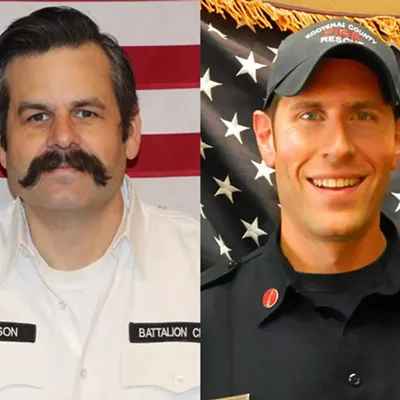But we cannot claim that the name "Spokane" is ours alone. Places in Montana, South Dakota, Missouri, Louisiana and Ohio also use it. In those last three states, they pronounce it differently than we do -- and truth be told, none of the Spokanes pronounce the name properly, if we go by what the original people here called themselves.
& lt;span class= "dropcap " & A & lt;/span & s fur trappers and missionaries first encountered the Spokane tribe, they discovered people who called their chief illm sp'q'n'i, roughly translated for a Salish expression for "Chief of the Sun." Since his people were his children, so to speak, the assumption was that the nation should be called "SPO-kan-ee," and everyone then and now took their name to mean "Children of the Sun." Gradually, this name came to be associated with the whole nation. Because the last vowel was only lightly accented, it came to be dropped in pronunciation.
As correspondence proceeded from this area, many writers used the name with the "e" at the end, even if in speaking most white folks were saying the name as we still do almost two centuries later. There were some, like Francis Cook, publisher of Spokane's first newspaper, who insisted that the "e" be dropped; Cook's newspaper went by the "Spokan" name. Several years later, when Cook's Spokan Times folded, he lost his forum for championing the "Spokan" name. It soon it became a relic.
& lt;span class= "dropcap " & B & lt;/span & ut how did at least five other places in the United States come to be called by the same name? In the case of the Missouri and Ohio towns, they received their names when their initial proposals were rejected by post office bureaucrats, who then suggested as an alternate the name of a little-known town way out in the northwestern part of the country. The residents grudgingly complied. Because they knew little about us or how our name came about, they assumed that because there was an "e" at the end of the name, it must be pronounced "Spo-KAIN" with a long "a" vowel sound. Today, there are comparatively few people living in the other places: Spokane, Missouri, with only 133 residents, is the only one still using a post office by that name. The Louisiana location is now a fishing village on an arm of the Mississippi River; the town in Ohio still has some residents clustered around an abandoned general store. The other Spokanes of note are a ghost town in South Dakota and a creek, ghost town and a range of hills just east of Helena, Montana.
Little is known about Spokane, Montana, except that it had a post office as far back as 1867. It was most likely a gold rush town that petered out when the gold did. The Spokane Hills nearby are composed of a rock called Spokane shale. Lewis and Clark, by the way, camped along Spokane Creek, which they called Pryor's Creek after their sergeant. They noted seeing large numbers of swans and shot some to eat.
The next stop on our Spokane journeys takes us to the Black Hills and a ghost town less than 10 miles from Mount Rushmore. Here in a small valley, Sylvester Judd discovered silver in 1891 and named the settlement after our city (which he hadn't yet visited). At its height, Spokane, South Dakota, had a small hotel, a school and a number of homes plus the mining buildings. Just a decade ago, the hotel, mining superintendent's office and school still stood; the mine, however, is now a Superfund site. Susan B. Anthony lectured at Spokane's schoolhouse, and another famous visitor was Rushmore sculptor Gutzum Borglum.
The next Spokane is another former mining town -- this time, in southern Missouri and in an area first visited by Spanish conquistadors. Although originally inhabited by the Sauk, Fox and Osage nations, it wasn't until after German and Swiss immigrants moved in that some springs near the town were discovered with amazing curative powers. Although 80 acres were set aside with stores, hotels, dance halls and churches, the boom soon faded: Spokane's waters were no more medicinal than any other Ozark spring water. Today, the area around Spokane in Christian County is noteworthy as a Civil War battle site (the county's Union militia defeated a Confederate force at Swan Creek); for its dairy herds, which a half-century ago were among the most productive of any place in the nation; and for the world's smallest cathedral.
Coming to Spokane, Louisiana, we find it was once home to an antebellum plantation of the deep South, part of which became a fishing resort in the 1930s. Its environs are the last resting place of the Spanish explorer Hernando de Soto, who "discovered" the Mississippi.
Concluding our journey with the easternmost Spokane, we arrive in northeastern Ohio. At its zenith, the post office/general store in Ohio's Spokane served some 200 people and was located near a Pittsburgh, Youngstown and Ashtabula railroad depot and a lumber yard. Today only the store remains. People walking along the Western Reserve Greenway unwittingly pass through Spokane on their treks.
& lt;span class= "dropcap " & F & lt;/span & rom the site of a hiking trail in Ohio to a fishing village in Louisiana, from a small town in the Missouri Ozarks to a ghost town in the Black Hills and on to a Montana site where Lewis and Clark trod two centuries ago, the name "Spokane" can be found in places a long way from where the name was first given to a people -- right here in the Pacific Northwest.
The author is greatly indebted to residents, librarians and historians from the areas mentioned. In particular, thanks to Zoe Stoltz in Montana, Wendell Lauth in Ohio, Bob Hayes and Jessie Sundstrom in South Dakota, and Pauline Flett of the Spokane Tribe.















